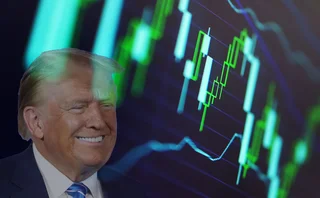
Banks seek to advance predictive pricing models
AI and machine learning-based tools could give FX desks the power to forecast currency movements
Artificial intelligence has increasingly become an all-encompassing term in financial circles. But in foreign exchange trading, what does it actually mean?
Banks have been vocal about how they have used AI for years when developing their execution algorithms, making documentation easier, and in their client chatbots.
But from a trading perspective, arguably the more impactful use case for market-makers is applying AI and machine learning models to tick data – looking at previous prices to build up a high degree of confidence in future patterns to ultimately forecast what the price of, say, euro/US dollar will be in the next 30 seconds, 10 minutes, or an hour, and so on.
Having a good idea of where the price will go over a given time horizon can inform a liquidity provider’s hedging strategy. For instance, if it shows the euro will appreciate against the dollar over the next five minutes, it makes sense for the desk to hold on to incoming euro inventory until it appreciates before hedging. That way, they can earn the appreciation on top of any bid/offer spread they capture.
There are a lot of unanswered questions about how much of the price will be dictated by these machines
Of course, this inventory management is what any good trader has always done, and some banks have worked on real-time data and analytics models that reflect the market in the present time. But the arrival of AI and machine learning has given them better forward-looking tools that can quantify those forecasts into their prices.
These techniques have been bread-and-butter for the big non-bank market-makers in recent times. It’s understood the large banks have dabbled in it as well over the years, and that smaller banks may look to take it up as the technology becomes easier to access.
What’s interesting are the time horizons that each group focuses on. Banks, for instance, tend to look at shorter periods such as 30 seconds, given internalisation can take them out of risk quickly, whereas the non-bank market-makers concentrate on longer timeframes owing to their greater appetite for this inventory risk.
Furthermore, when market volatility is much higher – like we saw last month – models that focus on patterns within much shorter timeframes can be stable.
On the bank side, though, the question also is how automated can this be? Dealers are understandably wary of allowing AI to take live decisions that affect pricing, but manual checks aren’t really suitable for such brief time horizons.
Some of the more advanced banks have set up internal teams dedicated solely to developing these kinds of predictive trading models.
But even at those banks that are yet to reach the point where they can take full advantage of AI, e-traders have been deploying it in plenty of other front-office areas.
Some look to AI to assess the price sensitivity of certain clients and then suggest to the human sales trader how the price configuration should be calibrated to that specific client. It’s then up to the human to go away and work out exactly how to adjust the client’s pricing.
A bank can also use AI to forecast expectations of demand. For example, if a corporate or asset manager client tends to trade EUR/USD at the same time of day, in the same size and for the same tenor, this gives the bank confidence about how to plan and adjust in expectation of these flows.
Ultimately, AI models have tremendous potential to become a bigger part of banks’ pricing engines. But there are a lot of unanswered questions about how much of the price will be dictated by these machines and whether any banks will be bold enough – or comfortable enough – to fully utilise them.
Editing by Lukas Becker
Only users who have a paid subscription or are part of a corporate subscription are able to print or copy content.
To access these options, along with all other subscription benefits, please contact info@risk.net or view our subscription options here: http://subscriptions.risk.net/subscribe
You are currently unable to print this content. Please contact info@risk.net to find out more.
You are currently unable to copy this content. Please contact info@risk.net to find out more.
Copyright Infopro Digital Limited. All rights reserved.
As outlined in our terms and conditions, https://www.infopro-digital.com/terms-and-conditions/subscriptions/ (point 2.4), printing is limited to a single copy.
If you would like to purchase additional rights please email info@risk.net
Copyright Infopro Digital Limited. All rights reserved.
You may share this content using our article tools. As outlined in our terms and conditions, https://www.infopro-digital.com/terms-and-conditions/subscriptions/ (clause 2.4), an Authorised User may only make one copy of the materials for their own personal use. You must also comply with the restrictions in clause 2.5.
If you would like to purchase additional rights please email info@risk.net
More on Our take
Why a Trumpian world could be good for trend
Trump’s U-turns have hit returns, but the forces that put him in office could revive the investment strategy
Roll over, SRTs: Regulators fret over capital relief trades
Banks will have to balance the appeal of capital relief against the risk of a market shutdown
Thrown under the Omnibus: will GAR survive EU’s green rollback?
Green finance metric in limbo after suspension sees 90% of top EU banks forgo reporting
Has the Collins Amendment reached its endgame?
Scott Bessent wants to end the dual capital stack. How that would work in practice remains unclear
Talking Heads 2025: Who will buy Trump’s big, beautiful bonds?
Treasury issuance and hedge fund risks vex macro heavyweights
The AI explainability barrier is lowering
Improved and accessible tools can quickly make sense of complex models
Do BIS volumes soar past the trend?
FX market ADV has surged to $9.6 trillion in the latest triennial survey, but are these figures representative?
DFAST monoculture is its own test
Drop in frequency and scope of stress test disclosures makes it hard to monitor bank mimicry of Fed models








